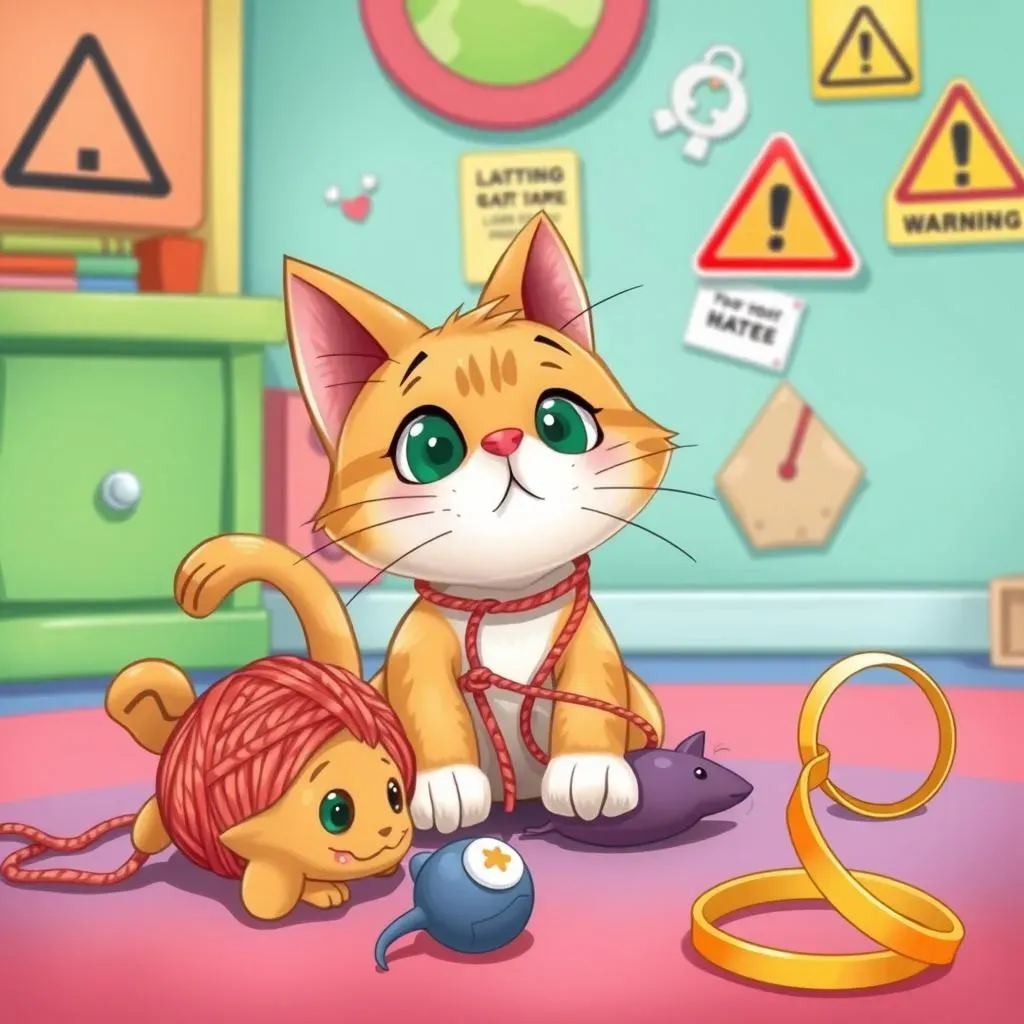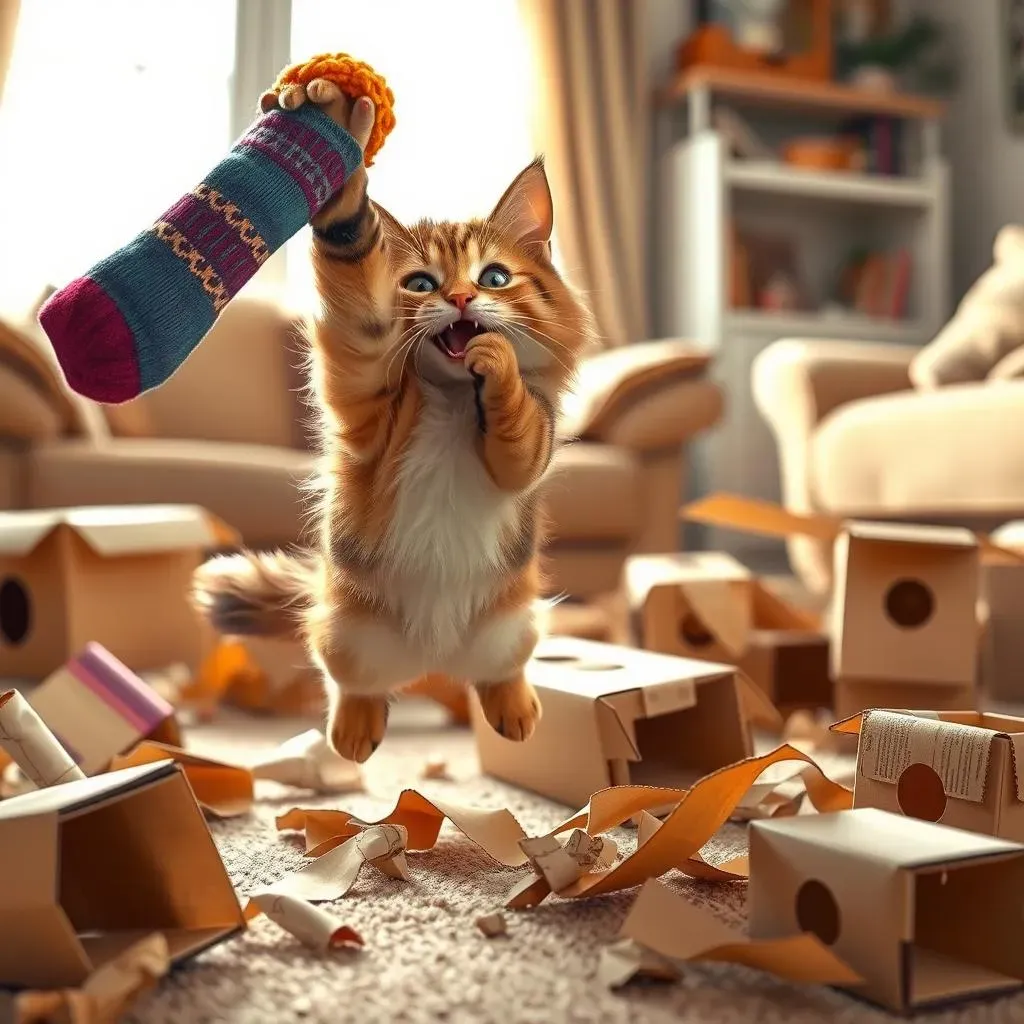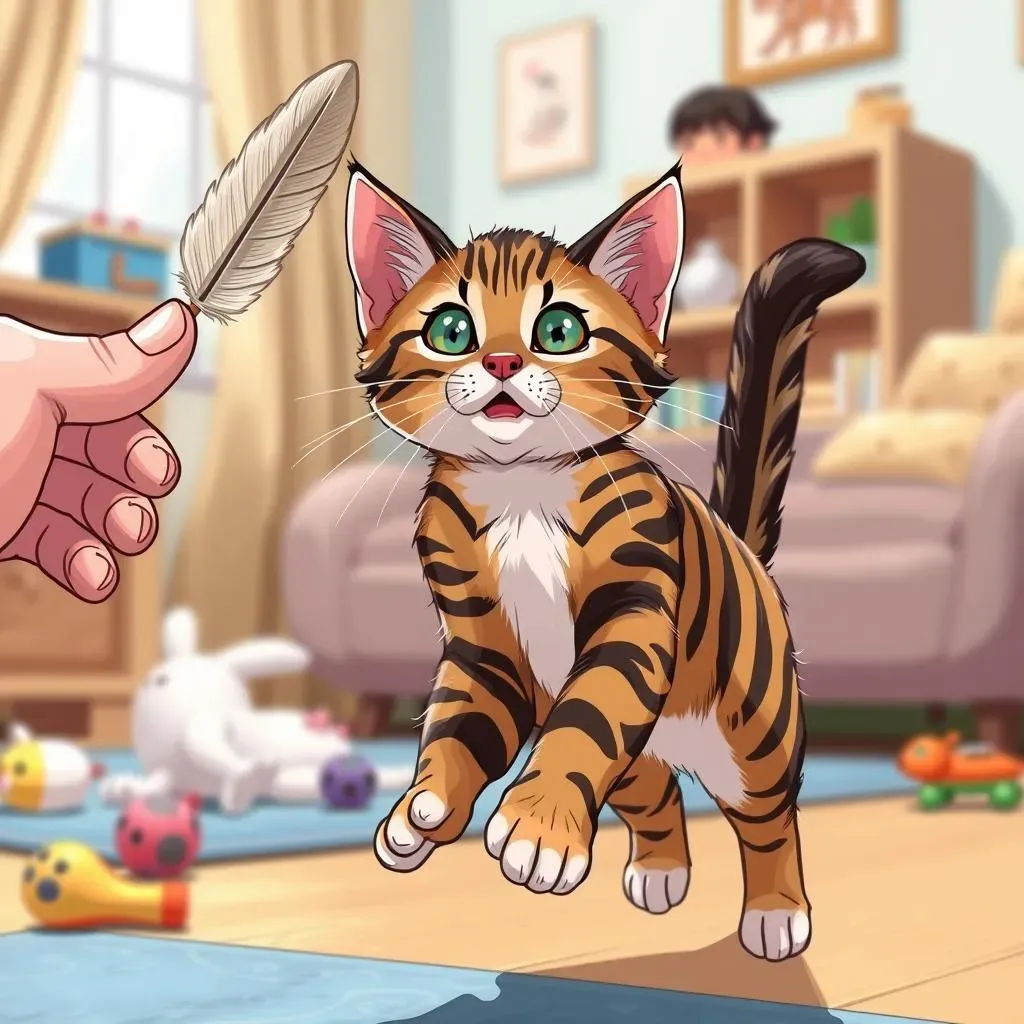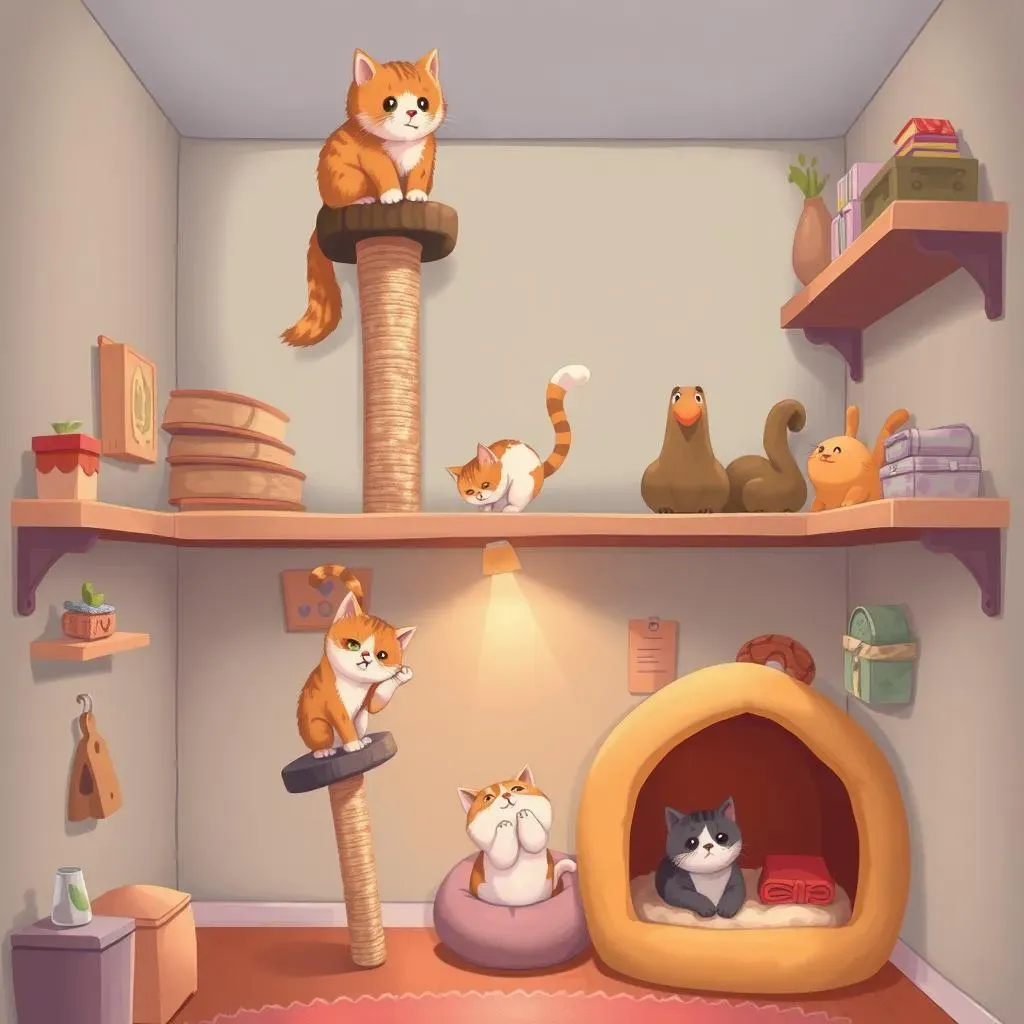Table of Contents
As cat owners, we adore spoiling our feline friends, and nothing says "I love you" like a mountain of new toys. But before you empty the pet store shelves, let's talk about what toys are safe for cats. Playtime is essential for a cat's mental and physical well-being, helping them burn energy, satisfy their hunting instincts, and prevent boredom. However, not all toys are created equal. Some can pose serious hazards, leading to choking, intestinal blockages, or even poisoning. In this guide, we'll explore the world of cat toys, separating the safe bets from the potential dangers. We'll delve into materials to embrace, designs to avoid, and even some fun DIY options you can whip up at home. Plus, we'll cover how to supervise playtime and create an overall enriching environment that keeps your kitty happy, healthy, and out of harm's way. So, let’s make sure those playful pounces and batting paws are always a source of joy, not a trip to the vet!
Choosing Safe Toys for Cats: A Purrfect Guide

Choosing Safe Toys for Cats: A Purrfect Guide
Durable Delights: Toys That Can Take a Beating
When considering what toys are safe for cats, durability is key. Cats, especially kittens, can be surprisingly destructive. A toy that falls apart easily poses a choking hazard or could lead to the ingestion of small parts. Look for toys made from sturdy materials that can withstand vigorous play. Think solid balls (golf balls are a no-no, though!), cardboard scratchers that won't easily shred into tiny pieces, and tunnels made from durable fabric.
Sturdy plush toys can also be a good option, but always inspect them regularly for any signs of wear and tear. If you see loose seams, exposed stuffing, or detached parts, it's time to retire the toy. Felt toys are another great choice, as they are generally quite durable and less likely to fall apart than cheaper plush alternatives. Remember, a slightly higher price tag often translates to better quality and a safer playtime experience for your furry friend.
Puzzle Power: Engaging Their Minds Safely
Beyond physical activity, mental stimulation is crucial for a happy cat. Puzzle toys and treat-dispensing toys are excellent for engaging their minds and satisfying their natural hunting instincts. These toys require cats to solve a problem or manipulate a mechanism to access a reward, like a tasty treat or a bit of kibble. This keeps them entertained and prevents boredom, which can often lead to destructive behaviors.
When selecting puzzle toys, prioritize those made from durable, non-toxic materials. Avoid any toys with small, easily removable parts that your cat could swallow. Also, make sure the toy is appropriately sized for your cat. A toy that's too small could be a choking hazard, while one that's too large might be frustrating and discourage them from playing. Always supervise your cat during their first few play sessions with a new puzzle toy to ensure they understand how it works and that they're not trying to chew or destroy it.
The Danger Zone: Toys to Avoid for Your Cat's Safety

The Danger Zone: Toys to Avoid for Your Cat's Safety
String Theory: A Tangled Web of Danger
so you're stocking up on toys, but hold up! Let's talk about what toys are safe for cats and which ones are a definite no-no. First up: strings. Those dangly, enticing strings attached to some cat toys might seem like a feline dream, but they're a serious hazard. If swallowed, string can cause a linear foreign body obstruction, which is basically a fancy way of saying it can wreak havoc on your cat's intestines. The string can get tangled, causing the intestines to bunch up like an accordion. This can lead to severe pain, vomiting, and even require surgery to remove. Even seemingly harmless dental floss can cause this.
And it's not just attached strings we're talking about. Things like yarn, ribbon, and even those little elastic hair ties can pose the same risk. Cats love to bat them around and chew on them, and before you know it, they've swallowed a piece. So, as tempting as it is to let your cat play with that ball of yarn, resist! Opt for toys without strings or remove them entirely. Your cat's safety is worth more than a few minutes of amusement.
- Avoid: Toys with long strings, yarn, ribbon, dental floss, elastic hair ties
- Why: Risk of intestinal obstruction, strangulation
- Safer Alternatives: String-free toys, laser pointers (use responsibly!)
Small Parts, Big Problems: Choking Hazards Galore
Next up on the danger list: small parts. We're talking about those tiny bells, plastic eyes, and little decorative pieces that often adorn cat toys. These might seem innocuous, but they're a major choking hazard. Cats are curious creatures, and they love to explore the world with their mouths. If a small part detaches from a toy, your cat might swallow it, leading to choking or, even worse, an intestinal blockage. And trust me, you do not want to deal with either of those scenarios.
It's not just intended toy parts we need to worry about, either. Think about common household items that cats might play with, like rubber bands, paper clips, or even those little silica gel packets you find in new shoes. These seemingly harmless objects can be incredibly dangerous if ingested. So, do a sweep of your house and make sure to keep these items out of your cat's reach. When choosing cat toys, opt for those that are well-constructed and don't have any small, easily detachable parts. A little extra caution can go a long way in keeping your feline friend safe.
Hazard Type | Examples | Potential Risks |
|---|---|---|
Small Detachable Parts | Bells, plastic eyes, decorative pieces | Choking, intestinal blockage |
Household Items | Rubber bands, paper clips, silica gel packets | Ingestion, toxicity |
DIY Cat Toys: Making Safe and Fun Options at Home

DIY Cat Toys: Making Safe and Fun Options at Home
Sock It to 'Em: The Ultimate Sock Toy
Alright, so you're looking for some budget-friendly and safe ways to entertain your feline overlord? Let's dive into the world of DIY cat toys! Forget those expensive, store-bought options – you probably have everything you need lying around the house. First up, the classic sock toy. Grab an old sock (clean, please!), stuff it with some catnip, crinkle paper, or even just some extra fabric scraps. Tie a knot at the end, and voila! Instant kitty entertainment. You can even get fancy and sew it shut for extra durability, but a simple knot usually does the trick. Just make sure there aren't any loose threads that your cat could pull out and swallow.
Want to kick it up a notch? Add some feathers to the end for extra visual appeal, or tie a few knots along the length of the sock to create different textures for your cat to explore. This is a great way to recycle old socks that have lost their mate or have holes in them. Plus, you know exactly what's going inside, so you can rest assured that it's safe for your furry friend. Just be prepared to make a new one every so often, as these tend to be a favorite target for playful claws and teeth!
Cardboard Creations: Unleash Their Inner Hunter
Next on our DIY adventure: cardboard! Don't toss those empty boxes just yet – they're a goldmine for cat toys. A simple cardboard box can provide hours of entertainment as your cat explores, hides, and pounces. Cut some holes in the sides for extra intrigue, or create a maze by taping multiple boxes together. You can even sprinkle some catnip inside to entice them to explore. For a more interactive toy, try cutting cardboard into different shapes, like circles or squares, and stringing them together with twine or ribbon (making sure the twine or ribbon is very short and sturdy, so it cannot be ingested). This creates a dangling mobile that your cat can bat and chase.
Another fun idea is to create a scratching post out of cardboard. Simply roll up several layers of cardboard and secure them with glue or tape. This provides a safe and satisfying outlet for your cat's scratching instincts, saving your furniture from their sharp claws. Remember to use non-toxic glue and tape, and always supervise your cat during playtime to ensure they're not ingesting any cardboard. With a little creativity, you can transform ordinary cardboard into a wonderland of fun for your feline friend!
Toy Type | Materials | Instructions | Safety Notes |
|---|---|---|---|
Sock Toy | Old sock, catnip, fabric scraps | Stuff sock, tie a knot | Ensure no loose threads |
Cardboard Box | Cardboard box, scissors | Cut holes, create a maze | Supervise playtime, use non-toxic materials |
Maximizing Playtime: Ensuring Safe Interaction with Your Cat's Toys

Maximizing Playtime: Ensuring Safe Interaction with Your Cat's Toys
Supervise, Supervise, Supervise: Eyes on the Prize (or the Pounce)
Alright, you've got the safe toys, you've cleared the danger zone, now let's talk about maximizing playtime while ensuring safe interaction with your cat's toys. The number one rule? Supervise! I know, I know, you're busy, but leaving your cat unattended with a toy, especially a new one, is like leaving a toddler alone with a box of crayons – you never know what kind of mess (or worse) you'll come back to. Supervision allows you to monitor how your cat is interacting with the toy, identify any potential hazards, and intervene if necessary. Are they trying to chew off a piece? Are they getting tangled in a string? Are they losing interest and starting to chew on something they shouldn't? By keeping a watchful eye, you can prevent accidents and ensure playtime remains a positive experience.
Think of it like this: you're not just a cat owner, you're a playtime referee! Your job is to make sure everyone plays fair and stays safe. Plus, supervising playtime is a great way to bond with your cat. You can encourage them, praise them, and even join in the fun! A little interaction goes a long way in strengthening your relationship and providing your cat with the mental and physical stimulation they need.
Regular Toy Inspections: A Stitch in Time Saves Nine Lives
So, you're on top of supervision, great! But the work doesn't stop there. Regular toy inspections are crucial for maintaining a safe playtime environment. Just like you wouldn't let your car go without an oil change, you shouldn't let your cat's toys go without a check-up. Over time, toys can become worn, damaged, or even contaminated. Seams can loosen, small parts can detach, and bacteria can accumulate. A quick inspection can help you identify potential hazards before they become a problem.
Make it a habit to examine your cat's toys at least once a week. Look for any signs of wear and tear, such as loose seams, exposed stuffing, or detached parts. Check for any sharp edges or broken pieces that could injure your cat. Give the toys a good sniff to make sure they're not contaminated with anything harmful. If you find any damaged or unsafe toys, discard them immediately. It's better to be safe than sorry! Replacing worn-out toys is a small price to pay for your cat's health and well-being.
Inspection Checklist | Action |
|---|---|
Loose Seams | Repair or discard toy |
Detached Parts | Discard toy |
Sharp Edges | Smooth or discard toy |
Contamination | Clean or discard toy |
Beyond Toys: Creating a Safe and Enriching Environment for Your Cat

Beyond Toys: Creating a Safe and Enriching Environment for Your Cat
Vertical Exploration: Cat Trees and Shelves
so you've got the toys covered, but creating a safe and enriching environment for your cat goes way beyond just playthings. Think about it from their perspective: they're natural climbers and observers. Providing vertical space is crucial for their well-being. Cat trees and shelves allow them to survey their kingdom from a safe vantage point, satisfying their instincts and reducing stress. A good cat tree should be sturdy, tall enough to offer a good view, and have multiple levels for climbing and lounging.
Shelves are another great option, especially if you're short on floor space. You can install them along walls to create a cat highway, allowing your cat to move freely around the room without ever touching the ground. Make sure the shelves are securely mounted and can support your cat's weight. Add some soft bedding or a scratching surface to make them even more appealing. Remember, the goal is to create a stimulating and engaging environment that caters to your cat's natural behaviors.
Scratch That Itch: Providing Safe Scratching Outlets
Speaking of natural behaviors, let's talk about scratching! Scratching is essential for cats – it helps them maintain their claws, stretch their muscles, and mark their territory. If you don't provide appropriate scratching outlets, your cat will likely turn to your furniture instead. The key is to offer a variety of scratching surfaces and find what your cat prefers. Some cats like vertical scratching posts, while others prefer horizontal scratchers. Some like sisal, while others prefer cardboard or carpet.
Experiment with different materials and orientations to see what your cat enjoys the most. Place the scratching posts in prominent locations, such as near their sleeping area or in areas where they like to hang out. You can even sprinkle some catnip on the scratcher to entice them to use it. And remember, consistency is key! Once your cat starts using the scratching post, make sure to keep it clean and in good condition. A little effort can go a long way in saving your furniture and keeping your cat happy.
Scratching Post Type | Material | Placement |
|---|---|---|
Vertical | Sisal, carpet | Near sleeping area |
Horizontal | Cardboard, carpet | In high-traffic areas |
Safe Havens: Creating Secure Retreats
Last but not least, let's talk about safe havens. Cats need a place where they can retreat and feel secure, especially when they're feeling stressed or overwhelmed. This could be a cozy bed, a covered carrier, or even just a quiet corner of a room. The key is to provide a space where your cat can relax and feel protected. Make sure the safe haven is easily accessible and away from loud noises or disturbances.
You can also add some comforting items, such as a soft blanket or a favorite toy. If you have multiple cats, make sure each cat has their own safe haven to avoid conflicts. Creating a safe and secure environment is essential for your cat's emotional well-being. It helps them cope with stress, reduces anxiety, and promotes a sense of security. And a happy, secure cat is a joy to have around!
Wrapping Up: Prioritizing Safety and Fun for Your Feline Friend
Choosing the right toys for your cat is more than just a matter of fun and games; it's about ensuring their safety and well-being. By being mindful of the materials, construction, and potential hazards associated with different toys, you can create a playtime experience that's both enriching and secure. Remember to supervise your cat during play, regularly inspect toys for damage, and when in doubt, opt for safer alternatives. A little extra care and attention will go a long way in keeping your furry companion happy, healthy, and entertained for years to come.